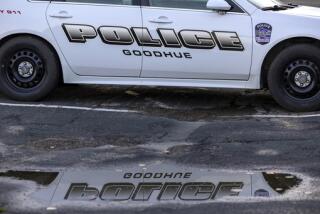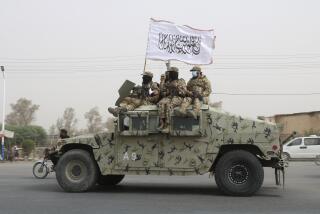U.S. plans to beef up rural police forces in Afghanistan
- Share via
WASHINGTON — The Obama administration plans to double the size of a rural police force in Afghanistan and arm it with heavier weapons to fight insurgents as U.S. troops withdraw, despite Pentagon and Afghan government concern about the village self-defense units becoming predatory criminal gangs or defecting to the Taliban.
The danger was highlighted Friday when a new member of the Afghan Local Police shot and killed two U.S. special operations troops and wounded a third moments after they gave him his service weapon during a ceremony for new recruits in the western province of Farah.
The attacker, who had joined the force just five days earlier, was about to take part in his first weapons-training session on a firing range. Instead, he opened fire on the American troops and fellow police. He was killed by return fire.
It was the latest in an intensifying spate of lethal “insider” attacks on NATO troops by Afghan soldiers, police and other government forces, causing growing alarm at the Pentagon. Afghan security forces have killed 24 Americans and 15 other Western soldiers so far this year. Nine have died in the last 11 days.
A 122-page report by the Defense Department’s inspector general reveals glaring problems within the rural police system, which was set up with U.S. backing two years ago and has become a pivotal part of the American strategy to safeguard territorial gains and maintain political stability as Western nations withdraw most combat forces by the end of 2014.
U.S. Marine Gen. John Allen, the commander of the NATO military force in Afghanistan, has ordered the 16,000-strong rural police force to be increased to 30,000 officers over the next two years, and then possibly expanded further.
In addition to equipping the police officers with AK-47 assault rifles, the Pentagon this year began supplying them with Russian heavy machine guns after local commanders complained that they were outgunned by Taliban insurgents.
The report, issued last month, credits the police with “significant and unexpected success” in expelling insurgent fighters from some remote villages and districts.
But many Afghan officials worry that the widely dispersed units will evolve into marauding criminal gangs or free-wheeling militias loyal to local warlords after departing U.S. forces stop paying their salaries, according to the inspector general’s report.
“Why would I arm the villagers when they may use those weapons against the [government] in the future?” provincial governors and district chiefs in eastern Afghanistan asked U.S. special forces officers, according to the report.
For that reason, officials at the Afghan Ministry of Defense are opposing U.S. plans to double the size of the village guard force and increase its firepower, the report notes.
Local elders are supposed to guarantee the loyalty of police in the villages where they are recruited. But adding thousands more recruits over the next two years increases the risk that insurgents will infiltrate the force and that village units could become private armies for local leaders, the report warns.
Regular Afghan police in each province are supposed to oversee the local units. But there is “very little trust” between the two forces because provincial police are afraid that the village guards “would use their weapons against them,” a senior U.S. logistics officer told investigators.
The Afghan Ministry of Interior is supposed to supply and pay the village police officers. But the system is weak, the report says, in part because the units are scattered in remote areas and because of concern about “arming future hostile ethnic militias.”
Many of the village police officers are from predominantly Pashtun areas. The Taliban is heavily Pashtun.
Army Gen. David H. Petraeus, who now heads the CIA, proposed creating the Afghan Local Police in 2010 when he commanded the war in Afghanistan. President Hamid Karzai initially resisted, concerned that some Afghan officials would try to use the units as private militias.
Petraeus eventually won Karzai’s support by promising that the Ministry of Interior, which the central government controls, would oversee and pay the force. He also said the program would be temporary, with the village units incorporated into the regular police or disbanded.
With the insurgency still raging, his successor, Gen. Allen, has abandoned those plans.
Allen plans to keep the local police force intact after 2014 and use it as a “strategic hold force” to help keep insurgents from returning to areas in the east and south that U.S. troops have managed to clear, the report says.
Allen has ordered the U.S. special operations command to look at expanding the local police to more than the current authorized level of 30,000, though the final size hasn’t been decided.
“The long-term plan is to keep them around,” said Col. Tom Collins, a spokesman for Allen. “All these things come down to funding, however.”
It is cheaper and quicker to train and equip local defense units than regular army and police.
With international funding drying up, Afghan security forces are expected to shrink in size in coming years from 352,000 to 280,000 or less, creating more need for local police, U.S. officers said.
The latest “insider” attacks haven’t bolstered confidence in the police, however. In addition to Friday’s attack, local police have taken part in at least three recent fatal shootings.
Last week, an Afghan officer helping train local police gunned down three special operations Marines in Helmand province. In another incident, a member of a local police unit gunned down a U.S. Armysergeant at a checkpoint in Paktika province, near the Pakistan border.
In late March, a policeman in Paktika province killed nine fellow officers. He first slipped drugs into their tea, then slaughtered them after they passed out.
U.S. officials say the attackers have various motivations. Some have personal grievances, others undergo “self-radicalization” after seeing anti-Western propaganda describing Americans and allies as infidels. Still others are Taliban sympathizers who infiltrate the Afghan security forces.
Allen said this year that more than half of the attacks involved Taliban supporters.
In a statement this week, Mullah Mohammed Omar, the secretive Taliban leader believed to be living in Pakistan, praised insurgents for secretly joining the Afghan army and police to “easily carry out decisive and coordinated attacks, inflicting heavy losses on the enemy both in life and equipment.” Other insurgents desert to the Taliban, he said, “carrying their heavy and light weapons and ammunition, after leaving the ranks of the enemy.”
Times staff writer Laura King in Kabul, Afghanistan, contributed to this report.
More to Read
Sign up for Essential California
The most important California stories and recommendations in your inbox every morning.
You may occasionally receive promotional content from the Los Angeles Times.














